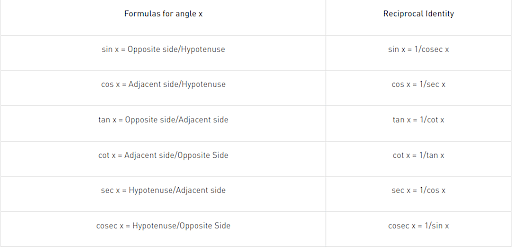Evaluate the following.
(i) sin60° cos30° + sin30° cos 60°
(ii) 2tan245° + cos230° - sin260°
(iii) \(\frac{cos 45°}{sec 30°+cosec30°}\)
(iv) \(\frac{sin\ 30°+tan\ 45°cosec\ 60°}{sec\ 30°+cos\ 60°+cot\ 45°}\)
(v) \(\frac{5cos^260°+4sec^230°-tan^245°}{sin^230°+cos^230°}\)
Evaluate the following.
(i) sin60° cos30° + sin30° cos 60°
(ii) 2tan245° + cos230° - sin260°
(iii) \(\frac{cos 45°}{sec 30°+cosec30°}\)
(iv) \(\frac{sin\ 30°+tan\ 45°cosec\ 60°}{sec\ 30°+cos\ 60°+cot\ 45°}\)
(v) \(\frac{5cos^260°+4sec^230°-tan^245°}{sin^230°+cos^230°}\)
Solution and Explanation
(i) sin60° cos30° + sin30° cos 60°
\(= \frac{\sqrt3}{2} ×\frac{\sqrt3}{2} + (\frac{1}{2}) ×(\frac{1}{2} )\)
\(=\frac{ 3}{4}+\frac{1}{4} =\frac{ 4}{4} =1\)
(ii) 2tan245° + cos230° - sin260°
\(= 2(1)^2 + \left(\frac{\sqrt3}{2}\right)^2-\left(\frac{\sqrt3}{2}\right)^2\)
= 2 + 0
= 2
(iii) \(\frac{cos\ 45°}{(sec\ 30°+cosec\ 30°)}\)
\(=\frac{\left (\frac{1}{\sqrt2}\right) }{\left [\left(\frac{2}{\sqrt3}\right) + 2\right]}\)
\(= \frac{\left(\frac{1}{\sqrt2}\right) }{ \left[\frac{(2 + 2\sqrt3)}{\sqrt3}\right]}\)
\(=\frac{ (1 × \sqrt3) }{ \left[\sqrt2 × (2 + 2\sqrt3)\right]}\)
\(= \frac{\sqrt3 }{ \left[2\sqrt2(\sqrt3 + 1)\right]}\)
Multiplying numerator and denominator by \(\sqrt2 (\sqrt3 - 1)\), we get
\(= \frac{\sqrt3 }{ \left[2\sqrt2(\sqrt3 + 1)\right]} × \frac{\sqrt2 (\sqrt3 - 1) }{ \sqrt2 (\sqrt3 - 1)}\)
\(=\frac{ (3\sqrt2 - \sqrt6) }{ 4(3 - 1)}\)
\(=\frac{ (3\sqrt2 - \sqrt6) }{ 8}\)
(iv) \(\frac{(sin\ 30° + tan\ 45° - cosec\ 60°) }{(sec\ 30° + cos\ 60° + cot\ 45°)}\)
\(= \left[\frac{\frac{1}{2} + 1 - \frac{2}{\sqrt3} }{ \frac{2}{\sqrt3} + \frac{1}{2} + 1}\right]\)
\(=\frac{ \frac{3}{2} - \frac{2}{\sqrt3} }{ \frac{2}{\sqrt3} + \frac{3}{2}}\)
\(= \left[\frac{{\frac{3\sqrt3 - 4}{2\sqrt3}} }{ {\frac{4 + 3\sqrt3}{2\sqrt3}}}\right]\)
\(=\frac{ (3\sqrt3 - 4) }{ (3\sqrt3 + 4)}\)
Multiplying numerator and denominator by \(3\sqrt3 - 4\), we get
\(=\frac{ (3\sqrt3 - 4)(3\sqrt3 - 4) }{ (3\sqrt3 + 4)(3\sqrt3 - 4)}\)
\(= \frac{(27 + 16 - 24\sqrt3) }{ (27 - 16)}\)
\(= \frac{(43 - 24\sqrt3) }{ 11}\)
(v) \(\frac{ (5cos^2 60° + 4sec^2 30° - tan^2 45°) }{ (sin^2 30° + cos^2 30°)}\)
\(= \frac{\left[5 × \left(\frac{1}{2}\right)^2 + 4 × \left(\frac{2}{\sqrt3}\right)^2 - (1)^2\right] }{\left [\left(\frac{1}{2}\right)^2 + \left(\frac{\sqrt3}{2}\right)^2\right]}\)
\(= \frac{(\frac{5}{4} + \frac{16}{3} - 1) }{ (\frac{1}{4} +\frac{ 3}{4})}\)
\(=\frac{\left [\frac{15 + 64 - 12}{12}\right] }{ \left[\frac{3 + 1}{4}\right]}\)
\(= \frac{\frac{67}{12} }{ \frac{4}{4}}\)
\(= \frac{67}{12}\)
Top Questions on Trigonometric Ratios of Some Specific Angles
- The value of $\cos 0^\circ$ will be:
- UP Board X - 2025
- Mathematics
- Trigonometric Ratios of Some Specific Angles
- If $\sin \theta = \cos \theta$, $0 \leq \theta \leq 90^\circ$, then the value of $\theta$ will be:
- UP Board X - 2025
- Mathematics
- Trigonometric Ratios of Some Specific Angles
- If $\tan 2A = 1$, where $2A$ is an acute angle, the value of $A$ will be:
- UP Board X - 2025
- Mathematics
- Trigonometric Ratios of Some Specific Angles
- The value of $\cos 60^\circ$ is:
- UP Board X - 2025
- Mathematics
- Trigonometric Ratios of Some Specific Angles
- In \( \triangle ABC \), \( DE \parallel BC \), if \( AD = x + 1 \), \( DB = 3x - 1 \), \( AE = x \), and \( EC = 4x - 3 \), then the value of \( x \) is:
- TS POLYCET - 2025
- Mathematics
- Trigonometric Ratios of Some Specific Angles
Questions Asked in CBSE X exam
In the adjoining figure, $\triangle CAB$ is a right triangle, right angled at A and $AD \perp BC$. Prove that $\triangle ADB \sim \triangle CDA$. Further, if $BC = 10$ cm and $CD = 2$ cm, find the length of AD.

- CBSE Class X - 2025
- Geometry
- The minimum number of identical bulbs of rating 4V, 6W, that can work safely with desired brightness, when connected in series with a 240V mains supply is:
- CBSE Class X - 2025
- Electrical Circuits
- If \(\sqrt{3} \sin \theta = \cos \theta\), then value of \(\theta\) is
- CBSE Class X - 2025
- Trigonometry
- The journeys of Anne Frank and Valli teach us the vital lesson that optimism and self-assurance empower women to rise above circumstances and overcome obstacles. Examine the similarities.
- CBSE Class X - 2025
- From the Diary of Anne Frank
- Suggest any two ways to increase women's representation in leadership roles.
- CBSE Class X - 2025
- Gender, Religion and Caste
Concepts Used:
Trigonometric Functions
The relationship between the sides and angles of a right-angle triangle is described by trigonometry functions, sometimes known as circular functions. These trigonometric functions derive the relationship between the angles and sides of a triangle. In trigonometry, there are three primary functions of sine (sin), cosine (cos), tangent (tan). The other three main functions can be derived from the primary functions as cotangent (cot), secant (sec), and cosecant (cosec).
Six Basic Trigonometric Functions:
- Sine Function: The ratio between the length of the opposite side of the triangle to the length of the hypotenuse of the triangle.
sin x = a/h
- Cosine Function: The ratio between the length of the adjacent side of the triangle to the length of the hypotenuse of the triangle.
cos x = b/h
- Tangent Function: The ratio between the length of the opposite side of the triangle to the adjacent side length.
tan x = a/b
Tan x can also be represented as sin x/cos x
- Secant Function: The reciprocal of the cosine function.
sec x = 1/cosx = h/b
- Cosecant Function: The reciprocal of the sine function.
cosec x = 1/sinx = h/a
- Cotangent Function: The reciprocal of the tangent function.
cot x = 1/tan x = b/a
Formulas of Trigonometric Functions:
